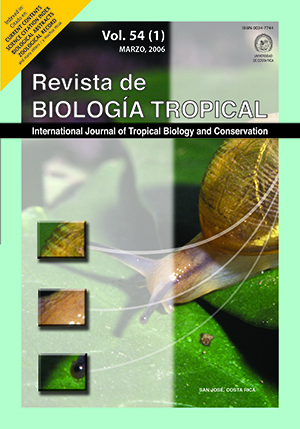Abstract
In Costa Rica’s Corcovado National Park, the fossorial land crab, Gecarcinus quadratus(Gecarcinidae), densely populates (1- 6 m-2) a region of forest extending from the Park’s Pacific coastline inland to ca. 600 m. Throughout this coastal forest (‘crabzone’), crabs selectively forage for fallen leaves and relocate them to subterranean burrow chambers. Comparisons between surface soils (0 - 15 cm) sampled from the crab-zone and forest lying immediately inland that is naturally devoid of crabs (‘crabless zone’) suggest that crabzone top soils contained less organic carbon and fewer fine and very fine roots. In contrast, soils sampled from 70 - 100 cm depths in the crabzone contained twice the carbon of the crabless zone during the dry season but similar values during the wet season. Two years of experimental crab exclusion from 25 m2 replicates established in the crabzone resulted in 16% more organic carbon content in surface soils relative to baseline conditions (n.s.) and 22% more carbon than final control values (P < 0.05). Excavations of burrow chambers, with an average (± SD) depth of 48 ± 12 cm, indicated localized, subterranean pockets of elevated (+ 60 %) organic carbon and increased densities of fine and very fine roots relative to same-depth samples from the crabzone unassociated with burrows chambers.
##plugins.facebook.comentarios##

This work is licensed under a Creative Commons Attribution 4.0 International License.
Copyright (c) 2006 Revista de Biología Tropical


